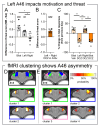Dysfunction in primate dorsolateral prefrontal area 46 affects motivation and anxiety
- PMID: 40839738
- PMCID: PMC7618107
- DOI: 10.1126/science.adx4142
Dysfunction in primate dorsolateral prefrontal area 46 affects motivation and anxiety
Abstract
The dorsolateral prefrontal cortex (dlPFC) is a higher-order brain structure targeted for noninvasive stimulation for treatment-resistant depression. Nonetheless, its causal role in emotion regulation is unknown. We discovered that inactivating dlPFC area 46 in marmosets blunts appetitive motivation and heightens threat reactivity. The effects were asymmetric-dependent on the left hemisphere only-and were mediated through projections to pregenual cingulate area 32. The antidepressant ketamine blocked the appetitive motivational deficits through mechanisms within subcallosal cingulate area 25, an area linked with treatment success in dlPFC noninvasive stimulation. Our data uncover an integrated prefrontal network for area 46 that contributes to positive and negative emotion regulation that may be core to our understanding of symptoms and therapeutic strategies for treatment-resistant depression and anxiety.
Conflict of interest statement
Figures




Comment in
-
A shared circuit might link depression and anxiety.Science. 2025 Aug 21;389(6762):778-779. doi: 10.1126/science.aea0913. Epub 2025 Aug 21. Science. 2025. PMID: 40839748
References
MeSH terms
Substances
Grants and funding
LinkOut - more resources
Full Text Sources
Medical

